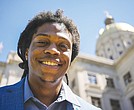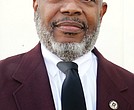Mayor Stoney pushes $1.4B plan to revitalize Downtown
Jeremy M. Lazarus | 11/8/2018, 6 a.m.

The grand plan to overhaul a big chunk of Downtown — including replacing the Richmond Coliseum with a new, larger arena — with a combination of taxpayer dollars and private investment funds is now headed to Richmond City Council for review.
Mayor Levar M. Stoney last week enthusiastically rolled out the ambitious plan to completely redo about 13 blocks near City Hall over the next five years with a projected investment of $1.4 billion.
The plan would change the face of an area that once was an African-American neighborhood known as Navy Hill, create hundreds of new affordable apartments, provide black-owned and minority companies with hundreds of millions of dollars in new contracts and generate thousands of new jobs to help lift untold Richmond residents out of poverty.
However, the development would for at least 18 years sop up most of the new real estate taxes and a major chunk of other taxes the development would generate, money that would be needed to cover the cost of the proposed new Coliseum and other public improvements, including improvements to Clay, 6th, 7th and Leigh streets, as well as the redevelopment of the historic Blues Armory.
Over the next 30 years, the development is projected to create $1.7 billion in new city taxes. But in the first 18 years, the lion’s share would need to be used to repay $350 million in city borrowing.
In the first 15 years, the city’s general fund is expected to gain only about $13 million a year in new funds, although in 20 to 30 years, the new money could grow to $60 million a year and then increase to $90 million a year, according to the city’s financial consultants.
One result is that the development would sideline any prospect for modernizing the majority of Richmond’s public school buildings for at least 20 more years, according to information the city released to the media.
And it would force the relocation of the centrally located Richmond Department of Social Services building that now sits across the street from City Hall. The mayor and his staff are proposing to move Social Services to a privately owned location at Jefferson Davis Highway and Walmsley Boulevard close to the border with Chesterfield County, nearly nine miles away in South Side.
Highlights of proposed Coliseum project
• $1.4 billion in construction involving 15 buildings
• Creation of thousands of new jobs (projections range from 6,000 to 20,000)
• Richmond Department of Social Services building to be relocated to 4700 block of Jefferson Davis Highway
Publicly financed from incremental tax growth
• 17,500 seat Coliseum, largest enclosed arena in state, 5th and Leigh streets.
• Three-story Blues Armory restored, with food market, music club and ballroom for new hotel, 6th and Marshall streets.
• Leigh Street brought up to grade between 6th and 8th streets.
• Clay Street reopened between 5th and 10th streets.
• 6th Street reopened between Marshall and Clay streets as pedestrian mall.
Privately financed by investors and lenders
• 527-room, 23-story Hyatt Regency hotel between Blues Armory and new Coliseum.
• 150-room replacement for Doorways Hospitality House hotel for hospital visitors, one element of replacement for Public Safety Building.
• Two large office buildings, with one at 5th Street next to new Coliseum, and one to be leased by Virginia Commonwealth University to fill most of space occupied by Public Safety Building.
• GRTC Transfer Center, Clay and 8th streets.
• Grocery store, 9th and Marshall streets.
• Retail space in eight apartment buildings for restaurants and other stores.
• 2,936 apartments in eight buildings, including 680 affordable units and 400 units for students. Locations: 163 units wrapping around Marriott Hotel parking deck, 5th and Marshall streets; 150 units wrapping around Coliseum parking deck, 8th and Clay streets; 250 units, 7th and Leigh streets; 600 units, 8th and Leigh streets; 457 units, 9th and Marshall streets; 512 units, 4th and Broad streets; 422 units, 6th and Broad streets; and 422 units, 6th and Grace streets.
With the mayor needing seven votes from the nine-member City Council to move this project forward, it is unclear what impact the issues of school buildings and the proposed relocation of the Social Services building will have on deliberations.
Several council members have expressed concerns. However, only 8th District Councilwoman Reva M. Trammell has said she would oppose the development.
At this point, the mayor is focusing on the positives of development, particularly the 12,000 construction jobs and 9,000 additional jobs that a Virginia Commonwealth University study projects would be created by the offices, hotel, retail operations and grocery stores.
The mayor also points to the major changes that would be ushered into a long staid area in a project that would add 14 new buildings, including the centerpiece arena. Eleven of the new buildings would be located within the blocks bounded by 5th, 10th, Leigh and Marshall streets.
Along with the new Coliseum, the development would include a new hotel, five apartment buildings, two new office buildings, a new indoor GRTC transit center and a new Doorways Hospitality House.
The development would not touch the John Marshall Courts Building or the Federal Building. It would retain two parking decks that would be wrapped with apartments, but would replace the city’s aging former Public Safety building and the Social Services building.
Three city-owned parking lots at 4th and Broad, 6th and Broad and 6th and Grace streets also would gain new apartment buildings as part of the total development.
In all, 2,936 apartments would be created between 2019 and 2024 if council gives the green light.
To carry out this plan, City Hall would team up with a private group, NH Foundation and led by Dominion Energy’s top executive, Thomas F. “Tom” Farrell II, to carry out a project Mr. Farrell and his group dreamed up and which would easily be the largest economic development project in the Richmond area.
As proposed — and only if the council approves it — the city would sell the mostly public property in the main project area to the city’s Economic Development Authority, which would then lease it to NH Foundation for up to 99 years. NH Foundation would then become responsible for covering the cost of operating and maintaining the Coliseum and for finding the private investors and lenders to put up the money to build the apartments and other buildings.
Underlying the whole plan is a proposal that would earmark the growth of real estate taxes to be generated both in the main project blocks and 57 other blocks to repay the $350 million that the city would use to build the new Coliseum, revamp the Blues Armory and pay for new infrastructure, including revamping several streets.
The total 80-block area, called a Tax Increment Financing District, or TIF, would be bounded by 1st and 10th streets and run from Interstate 64/95 to the Downtown Expressway.
The city’s general fund would continue to receive the same level of real estate taxes it does now from the 80-block area. Revenue from other city taxes, including sales, lodging, meals and admission, would continue to go to the general fund, except those generated in the main project area. Money from those taxes also would go to the TIF District to repay borrowing.
The 80-block TIF District is eight times as large as initially proposed, but was increased to ensure that there would be enough tax growth to pay off the $350 million in revenue bonds the city would sell, officials said.
Even before the City Council review begins, several members, including Parker C. Agelasto, 5th District, and Kim B. Gray, 2nd District, have expressed concern about the size of the TIF District and the tax dollars that would need to be used to pay the debt on the new Coliseum.
Other council members are worried about the proposed relocation of the Social Services operations, which could force people applying for food stamps and other services to travel more than an hour on public transit to get to the proposed new location.
“I have already told the mayor that would be unacceptable,” Councilwoman Ellen F. Robertson told the Free Press.







